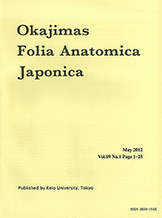All issues

Volume 89 (2012)
- Issue 4 Pages 93-
- Issue 3 Pages 57-
- Issue 2 Pages 27-
- Issue 1 Pages 1-
Predecessor
Volume 89, Issue 1
Displaying 1-4 of 4 articles from this issue
- |<
- <
- 1
- >
- >|
-
Jun A. MINAGUCHI, Ayako ABE, Hiromi UEDA, Prasarn TANGKAWATTANA, Kazus ...2012 Volume 89 Issue 1 Pages 1-5
Published: 2012
Released on J-STAGE: August 30, 2012
JOURNAL FREE ACCESSThe Hokkaido sika deer (Cervus Nippon yesoensis), the largest and most abundant of the sika deer subspecies in Japan, has recently attracted new attention as a target for leather production, in addition to its meat value. To provide funda-mental data for facilitating the effective use of skin for leather, the histological properties of skin at the shoulder, back and ab-dominal regions of male and female deer were compared. The results showed that the thickness of the outer skin layer was not significantly different across all regions irrespective of sex. Regarding collagen composition, we found that large-diameter col-lagen fibrils were heavily distributed in the shoulder of male deer, whereas small-diameter collagen fibrils were largely confined to the abdomen of female deer. We hope this regional histological data will lead to more efficient processing of Hokkaido sika deer skin for leather production.View full abstractDownload PDF (2078K) -
Hirokazu NARITA, Toshiki TANI, Yoshikazu TONOSAKI2012 Volume 89 Issue 1 Pages 7-13
Published: 2012
Released on J-STAGE: August 30, 2012
JOURNAL FREE ACCESSWe report the anatomical findings of a case of horseshoe kidney, and analyze the associations between kidney position and surplus renal arteries in horseshoe kidneys found in Japanese autopsies in the past. The horseshoe kidney of our case fused at the lower poles of the original kidneys. Its right and left upper poles were at the middle region of the first and second lumbar vertebrae, respectively. The kidney was supplied by eight arteries. Our analysis of the correlation between the ascent of a horseshoe kidney and the number of surplus arteries found no significant association. However, there was a significant association between the region of the kidney where the surplus arteries entered and the location where they diverged from the aorta. Therefore, the ascent of a horseshoe kidney is not necessarily arrested because of the existence of many surplus arteries. After a horseshoe kidney partially ascends, the arteries which might become normal renal arteries are generated. In our case, we observed large splenomegaly, and noted that the left upper pole was the lowest compared with the horseshoe kidneys in the past autopsy reports. We suggest it is necessary to consider additional influences that determine the position of a horseshoe kidney.View full abstractDownload PDF (1001K) -
Masakazu SHIBATA, Noboru GOTO, Jun GOTO, Naoko NONAKA2012 Volume 89 Issue 1 Pages 15-22
Published: 2012
Released on J-STAGE: August 30, 2012
JOURNAL FREE ACCESSAlong the raphe of the brain stem, a series of small neuronal groups can be observed in the medulla oblongata, the pons and the mesencephalon. The neurons located in and adjacent to the raphe are considered to produce mainly serotonin (5-HT). The groups of nuclei containing 5-HT were first reported in experimental animals in the early 1960s1). The presence of such nuclei, however, has not yet been brought to light in the human brainstem except the few atlases2, 3), although in several neuroanatomy textbooks4), extrapolated data are shown in the form of drawings as if they were the data from the human brain. The aim of this study is to present microscopic photos of such raphe nuclei made from serial sections of the human brainstem, and to clarify the differences between findings in human and textbook drawings from animal data.View full abstractDownload PDF (7504K) -
Masakazu SHIBATA, Noboru GOTO, Jun GOTO, Naoko NONAKA2012 Volume 89 Issue 1 Pages 23-25
Published: 2012
Released on J-STAGE: August 30, 2012
JOURNAL FREE ACCESSMorphological findings or evaluations of the nervous system have traditionally concentrated on cell somata; evaluations of the white matter have not been put forward up to now. This study was conducted to evaluate the white matter in the spinal cord with the LPH discriminative staining method which was proposed by Goto1). Thanks to the minimum shrinkage ratio (10 ± 0% in length) which this technique allows, it is possible to evaluate the sizes of nerve axons, and to compare the arrangement of nerve fibers in various parts of the spinal white matter. As the axonal sizes reflect nerve conduction velocities, we would like to emphasize that these sizes or the differences in the arrangement of axons may be important for a better understanding of neurosymptomatology.View full abstractDownload PDF (2562K)
- |<
- <
- 1
- >
- >|